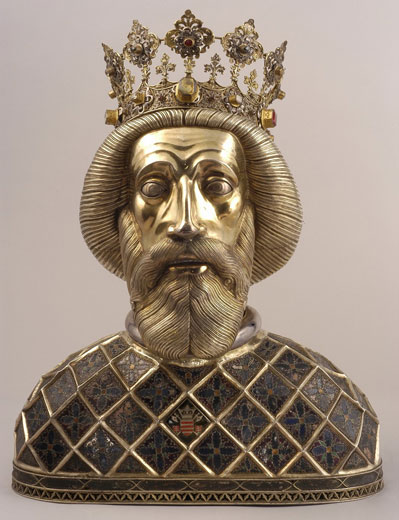 MEDIEVAL BULGARIAN CULTURE FROM THE 7th THROUGH THE 17th C.
MEDIEVAL BULGARIAN CULTURE FROM THE 7th THROUGH THE 17th C.
The medieval Bulgarian culture can be divided into two distinct periods - the first one marked by heathenism (7th-9th c.) and the second, post-Christianization (7th-l7th c.), marked by the conversion of faith. This differentiation is thus made on the basis of the ideological content pertinent to the culture of that epoch, content that draws the demarcation line between two entirely different cultural patterns.
The factors which had affected the development and had delineated the manifestation of Bulgarian culture should not be confined within the influence of the religion predominating in a given space of time. For example, one of the significant factors was the presence, or equally, the absence at times, of independent state and church institutions. Another important factor was the geographical position of the Bulgarian lands at the junction of the routes connecting Europe and Asia, i.e. Bulgaria had to play its allotted part of a two-way passage, linking two culturally strong worlds, exchanging constantly and actively their cultural values. Despite the dispiriting and almost permanent political confrontation between Asia and Europe during the Middle Ages, the Bulgarian culture, along with the Byzantine one, had acted as a laboratory for creative interaction and as an indispensable mediator in the onward transmission of culture in both directions. There is also one very important factor, or rather, a fact which should not be overlooked the Bulgarian people, state and church were never steeped in the xenophobia (fear of or irresponsiveness to anything foreign) that was customary in some other communities, nor were they blinkered by the dogmas of their own beliefs and values.
A characteristic feature of the spiritual development of the Bulgarian people during the
Middle Ages was its written culture, i.e. its letters and script. Rarely are we nowadays fully aware of the impact on the overall development made by each people which had created and promoted a written culture, nor of the advantages it could have enjoyed in the
antiquity. These are facts which, perhaps, were best illustrated by
Voltaire in saying that in the history of mankind there had been only two great inventions - that of the
wheel, which had helped eliminate distances and that of the
alphabet, which had made it possible to preserve, multiply and disseminate through into the future the information about the achievements both of forebears and contemporaries. Bulgarian culture-studying experts have confirmed the validity of the above statement with examples of the history of the Bulgarian lands. The
Thracians whom the authors of the antiquity described not only as the second biggest people on the earth but also as a people which had failed to create its own letters and
script, are well-known to have disappeared without trace, by contrast with the comparatively small Bulgarian people, which had survived in spite of its frightfully stormy historical lot in this part of the European continent.
The Bulgarians, who settled on the
Balkan Peninsula in
681 had brought with them a
runic alphabet of their own. Its characters and symbols, appearing in several hundred texts cut out on stone, metal and ceramics had probably had
idiographic meaning, i.e. one character signified one notion. The undemocratic nature of that alphabet was all too obvious.
http://everything2.com/index.pl?node=Medieval%20Bulgarian%20Culture
 Art in medieval Hungary
Art in medieval Hungary










